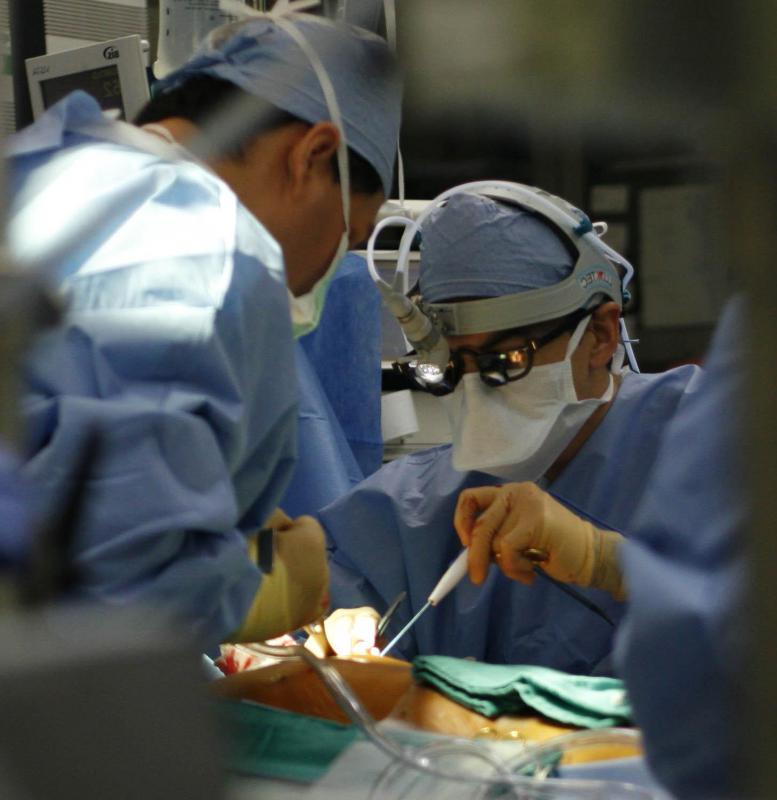At WiseGEEK, we're committed to delivering accurate, trustworthy information. Our expert-authored content is rigorously fact-checked and sourced from credible authorities. Discover how we uphold the highest standards in providing you with reliable knowledge.
What Are the Different Types of Cyst Excisions?
Cysts are sacs filled with fluid or solid masses. While they often may not pose a significant health risk, these objects can be both unsightly and painful. For these reasons, many patients seek cyst excisions, or cyst removal. Such measures often require fairly significant operations, but more minor outpatient surgical procedures are not uncommon. If a cyst occurs on the skin, the two surgical procedures of choice are complete excision or drainage followed by sac excision.
A medical professional may discover cysts directly beneath the skin or further inside the body. When a cyst occurs underneath the skin, it is known as an epidermoid — or sebaceous — cyst. Cysts can result from trauma, clogged pores, or bacterial infection. If the cyst becomes regularly inflamed or unsightly, surgical cyst excisions may be recommended.

One method for sebaceous cyst excisions involves drainage and subsequent sac removal. Since cysts are often filled with fluids, the liquid may need to be removed first. This task is accomplished by making a small cut on top of the cyst and then draining the fluid through this cut. Following drainage, the remaining sac is removed using scissors and forceps.

These microincision techniques for cyst excisions are sometimes preferable because they leave smaller scars. The two basic types of microincision are punch biopsy and minimal excision. Both follow the same basic procedure of cut, drainage, and removal. The primary difference is cut size. Punch biopsy techniques require excisions of about 0.16 inch (4 millimeters), whereas minimal excision only requires 0.07 to 0.12 inch (2 to 3 millimeter) cuts.

Despite the larger scars, conventional sebaceous cyst excisions are generally recommended because drainage makes inflammation and recurrence more likely. This type of excision removes the whole cyst at once. Skin separations are made across or around the cyst.
The physician may either use a scalpel or a device called a curved hemostat for whole cyst excisions. The former method is frequently called sharp dissection because it involves actual cutting. In contrast, the latter method, known as blunt dissection, separates and removes tissues along natural splits in the skin without cutting. Some conventional procedures use both sharp and blunt dissection.

Internal cysts have many of the same causes as external cysts, such as injury or blockage. Due to their possible proximity to important organs, however, removal of these cysts may be more crucial. On occasion, the cyst may be drained without surgical intervention through needles or catheters. If a cyst poses a potential risk, however, surgical removal from the afflicted area is advisable, provided the cyst is in a surgically safe location. As cysts can appear in various parts of the body, the depth and invasiveness of the surgery will depend on cyst location.
AS FEATURED ON:
AS FEATURED ON:















Discussion Comments
@Drentel - Everybody heals differently. Some people heal quickly; others not so quickly. However, I feel safe saying that in general a person who has an excision of a cyst and has it closed with stitches should find that the area heals in two to four weeks. I have a friend who had a cyst removed in this way, and she was back at work in a couple of weeks.
I should mention that she didn't have a particularly strenuous job at that time. She mostly sat behind a desk, and typing was about as strenuous of an activity as she completed at that time. This being said, she was fully recovered a month after the surgery, and her scar faded until it was barely noticeable. The location of the cyst also is a big factor in determining how quickly the incision area will heal.
@Drentel - I once had a cyst excision and the wound was left open. Believe me, this is not the best way to leave the wound in terms of the amount of time it takes to heal. In my case, the open wound took a couple of months to heal. And there wasn't a lot I could do in terms of work and chores during the time the wound was healing.
For me, the routine of changing the bandages was a big headache. Sometimes the bandages would stick to the wound, making it more difficult to get them off and a new one on. There was also a lot of pain in the beginning when I changed the bandages. After a few weeks, the pain decreased, but the whole process was still a big headache.
What should you expect in terms of general recovery when you have an excision of cyst procedure? How active can you be right after surgery?
Post your comments